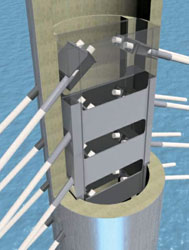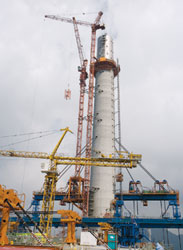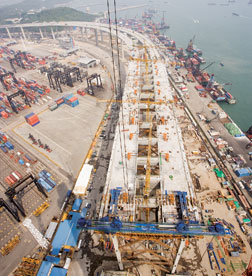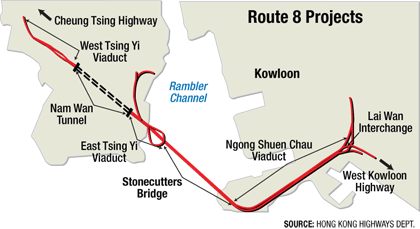...system is captive for up to two years in places, until such time that the permanent stay cables have been installed. Also, due to the longevity of the falsework service period, long-term settlement was a concern. Thus, even the falsework is founded on piles to bedrock.”
Crews also are prestressing the box girders in anticipation of the cable installation, says Steve Kite, Arup resident engineer. The prestressing mimics the effect the permanent stay cables will have in making the girders “sag.”
Work started six months earlier on the east side, because activity on the west side included reclamation of land for a container terminal. West estimates the learning curve has sped up construction of the west side’s backspans and tower by 30%. The joint venture is well under way with concrete backspans on the west side.
 Arup Steel boxes for cable anchorages are encased in both concrete and stainless steel layers within towers’ top sections.
|
On the east side, crews have completed erection of 88 m of steel box girders, using strand jacks to simultaneously lift them on either side of the tower. The girders transition between the concrete backspans and the steel girders of the main span to come.
These 4,000-tonne lift sections are comprised of six pairs of prefabricated deck units, 20 m wide and between 10 and 20 m long. The units are shipped to the site and welded together at ground level. With limited space at the base of the tower, the segments are hydraulically slid along steel rails to the spot where they are to be lifted. Each welded deck unit and its twin are then lifted as high as 75 m. The units must also move laterally in the air since the tower itself tapers.
On the west side, the first deck units are on site and being welded together, with the lifting operation there planned for October. In total 65 segments make up the 1,117.5-m length of steel deck, says Kite. Cross girders will be lifted and welded to connect the twin decks together. West says it takes about four days to weld segments together.
| + click to enlarge | |
 |  |
By the end of the year, crews plan to begin lifting main-span segments that will cantilever off the completed east pylon, says Kite. That will require “major coordination” with Hong Kong Kwai Chung Container Port, one of the world’s busiest. “Every five minutes ships pass by” in the channel, says West. Many of these are now supersized post-Panamax ships carrying up to 8,000 containers.
With those ships in mind, officials increased clearance of the main span from 66 m to more than 70 m. The main 53.5-m-wide deck is built on two parallel steel boxes, 4 m deep.
West says that barges shielded by tugboats will use global positioning systems to locate the proper spot in the busy channel for lifting segments into place as the main span erection sequence progresses. He anticipates eight to 10 days to lift, weld, install stay cables and stress a segment.
Stay cables are made of 7,000 tonnes of parallel wire strands that streamline the cable profile and will reduce impact of typhoons (ENR 12/5/05 p. 28). Two planes of cables will fan out to the anchorages every 18 m. The longest cable will be 540 m and weigh 70 tonnes, says Kite.
 Michael Goodman/ENR Backspans for dual highway mimic main span’s steel structure but need massive falsework.
|
“We’ll lift the reel to the deck level, unroll it along the deck, then lift it up to the socket” in the tower, he says. “Most U.S. cable-stayed systems use the individual strand system,” notes Kite. “They never lift an entire cable.”
The bridge’s 224 galvanized stay cables are designed by Japan’s Nippon Steel Engineering. CTLGroup, Skokie, Ill., performed testing of fatigue, waterproof levels and tensility. “Parallel wire strand stay cables provide a smaller aerodynamic profile rather than the multiple seven-wire strand bundles commonly used in cable stays,” says Thomas Weinnmann, CTL sensors and structural diagnostics group manager. “This can be an important attribute based on bridge exposure to high winds or bridge aesthetics. The disadvantage is, you lose the ability to replace or add additional strands to a stay cable, and the potential for additional layers of corrosion protection that epoxy- coated or greased and sheathed strands would provide.” Click here to watch a video of Steve Kike showing a typical stonecutters cable.
As a result, the acceptance testing program was “to my knowledge, the most comprehensive of any testing program performed,” he adds. CTL performed 11 tests on cable specimens ranging from 96 mm to 144 mm, each containing from 187 to 421 wires that were 7 mm thick.
Elsewhere
Hong Kong’s highway department also is moving on other Route 8 projects, including three tunnels and four viaducts. Two viaducts directly connect to Stonecutters. On the east side, the 2.2-km-long Ngong Shuen Chau Viaduct also must reach 60 m above ground to match Stonecutters’ backspans. China Harbour Engineering Co. Ltd. is launching 2,600 balanced cantilevered segments there under a $196-million contract.
 |
On the west side, the $129-million, 1-km-long East Ysing Yi viaduct uses spiraling ramps to tie into the bridge’s backspans. A 1.2-km twin tube tunnel links the east viaduct to the $188-million, 1.5-km West Tsing Yi viaduct. Bids for various contracts on the last 7.6 km of Route 8 will likely go out in 2008, says Hui.

Post a comment to this article
Report Abusive Comment